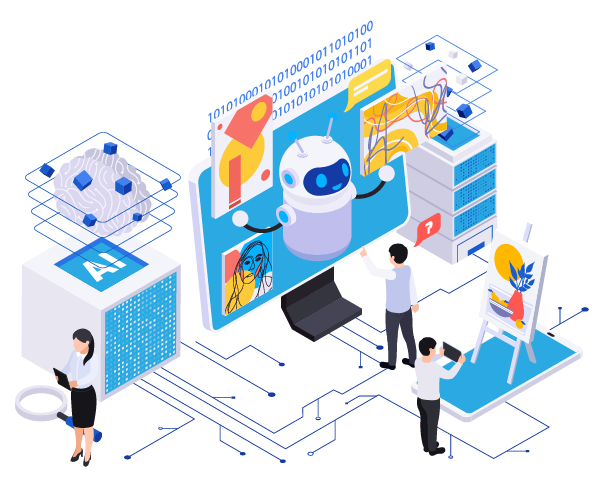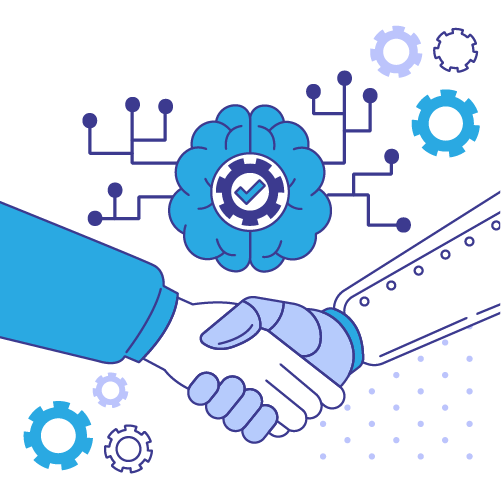Artificial Intelligence (AI) has become a cornerstone of modern technological advancements, with applications spanning across various industries from healthcare to finance, and entertainment to transportation. As AI continues to evolve, the need for ethical AI development becomes increasingly critical. Balancing innovation and responsibility in AI is not only a moral imperative but also a strategic necessity to ensure sustainable and equitable progress. This blog delves into the ethical considerations in AI development, emphasizing the importance of AI ethics guidelines, responsible AI practices, and AI bias mitigation.
The Importance of Ethical AI Development
Ethical AI development is essential to prevent the misuse of AI technologies and to promote fairness, transparency, and accountability. Unethical AI can lead to severe consequences, including privacy violations, discrimination, and the amplification of social biases. Therefore, incorporating ethical considerations into AI development from the outset is crucial to avoid these pitfalls and to foster trust in AI systems.
AI Ethics Guidelines
AI ethics guidelines are frameworks designed to guide the development and deployment of AI technologies. These guidelines typically emphasize principles such as fairness, accountability, transparency, and privacy. Various organizations and governments have developed AI ethics guidelines to ensure that AI technologies are developed and used responsibly.
One prominent example is the European Commission’s Ethics Guidelines for Trustworthy AI, which outline seven key requirements for AI systems:
1. Human Agency and Oversight: AI systems should empower human beings, allowing them to make informed decisions and maintain control over AI operations.
2. Technical Robustness and Safety: AI systems should be secure, reliable, and resilient against adversarial attacks and errors.
3. Privacy and Data Governance: AI systems should ensure data protection and provide individuals with control over their data.
4. Transparency: AI systems should be explainable, with transparent decision-making processes that are understandable to users and stakeholders.
5. Diversity, Non-discrimination, and Fairness: AI systems should be designed and used in a manner that prevents bias and promotes inclusivity.
6. Societal and Environmental Well-being: AI systems should contribute to the well-being of society and the environment.
7. Accountability: Mechanisms should be in place to ensure accountability for AI systems and their outcomes.
These guidelines serve as a foundation for ethical AI development, helping developers and organizations align their AI projects with ethical standards.

Responsible AI Practices
Implementing responsible AI practices involves integrating ethical considerations into every stage of AI development, from design to deployment. Here are some key practices to ensure responsible AI development:
1. Ethical Design
Ethical design involves embedding ethical principles into the design of AI systems. This includes considering the potential impacts of AI on different stakeholders and ensuring that AI systems are designed to promote positive outcomes while minimizing harm. Ethical design also involves conducting thorough impact assessments to identify and address potential ethical issues early in the development process.
2. Bias Mitigation
AI bias mitigation is a critical aspect of responsible AI development. Bias in AI systems can arise from biased training data, flawed algorithms, or unintended human biases. To mitigate bias, developers should:
Use Diverse and Representative Data: Ensuring that training data is diverse and representative of different populations can help reduce bias in AI systems.
Regularly Audit AI Systems: Regular audits of AI systems can help identify and address biases that may emerge over time.
Implement Fairness Algorithms: Fairness algorithms can be used to adjust AI models to reduce bias and promote equitable outcomes.
3. Transparency and Explainability
Transparency and explainability are essential for building trust in AI systems. Transparent AI systems provide clear information about how decisions are made, enabling users to understand and challenge AI outcomes. Explainability involves making AI models and their decisions understandable to non-experts. This can be achieved through techniques such as:
Interpretable Models: Using models that are inherently interpretable, such as decision trees or linear models.
Post-hoc Explanations: Providing explanations for decisions made by complex models through techniques like LIME (Local Interpretable Model-agnostic Explanations) or SHAP (SHapley Additive exPlanations).
4. Human-in-the-Loop
Human-in-the-loop (HITL) systems involve human oversight and intervention in AI decision-making processes. HITL approaches ensure that critical decisions are reviewed and validated by humans, reducing the risk of errors and biases. This approach is particularly important in high-stakes domains such as healthcare, finance, and criminal justice.
5. Continuous Monitoring and Evaluation
Responsible AI development requires continuous monitoring and evaluation of AI systems to ensure that they operate as intended and adhere to ethical standards. This involves:
Performance Monitoring: Regularly monitoring the performance of AI systems to detect and address any issues.
Ethical Audits: Conducting periodic ethical audits to evaluate the ethical implications of AI systems and their impact on stakeholders.
Feedback Mechanisms: Implementing feedback mechanisms to gather input from users and stakeholders, allowing for continuous improvement of AI systems.
AI Bias Mitigation
AI bias mitigation is a multifaceted challenge that requires a comprehensive approach. Bias in AI can manifest in various forms, including racial, gender, and socioeconomic biases. Addressing these biases is essential to ensure that AI systems are fair and equitable.
1. Understanding Bias
Understanding the different types of bias that can affect AI systems is the first step in addressing them. Common types of bias in AI include:
Data Bias: Bias that arises from biased or unrepresentative training data.
Algorithmic Bias: Bias introduced by flawed algorithms or model design.
Human Bias: Bias resulting from human prejudices and assumptions that influence AI development and deployment.
2. Strategies for Bias Mitigation
Several strategies can be employed to mitigate bias in AI systems:
Bias Detection and Measurement: Developing techniques to detect and measure bias in AI models is crucial for identifying and addressing bias. This can involve statistical analysis, fairness metrics, and benchmarking against diverse datasets.
Algorithmic Fairness: Implementing fairness-aware algorithms that are designed to reduce bias and promote equitable outcomes. Techniques such as adversarial debiasing, reweighting, and fairness constraints can be used to achieve this.
Inclusive Design: Ensuring that AI development teams are diverse and inclusive can help bring different perspectives and reduce biases in AI systems. Inclusive design practices involve actively involving underrepresented groups in the design and development process.
Ethical Review Boards: Establishing ethical review boards to oversee AI projects and ensure that ethical considerations are integrated into decision-making processes. These boards can provide guidance on ethical dilemmas and help address potential biases.

The Role of Regulations and Standards
Regulations and standards play a crucial role in promoting ethical AI development. Governments and regulatory bodies are increasingly recognizing the need for oversight and governance of AI technologies. Key regulatory frameworks and standards include:
The General Data Protection Regulation (GDPR): The GDPR provides guidelines for data protection and privacy, ensuring that AI systems handle personal data responsibly and transparently.
The AI Act: Proposed by the European Commission, the AI Act aims to establish a legal framework for AI, with a focus on ensuring the safety and fundamental rights of individuals.
IEEE Standards: The IEEE has developed several standards for ethical AI, including the IEEE 7000 series, which provides guidelines for addressing ethical concerns in AI and autonomous systems.
These regulations and standards help create a level playing field and ensure that AI developers adhere to ethical principles.

Conclusion
Balancing innovation and responsibility in AI development is essential for creating AI systems that are ethical, fair, and trustworthy. By adhering to AI ethics guidelines, implementing responsible AI practices, and actively mitigating bias, developers can ensure that AI technologies are developed and deployed in a manner that benefits society as a whole. The journey towards ethical AI development is ongoing, and it requires continuous effort, collaboration, and commitment from all stakeholders involved in the AI ecosystem.
As we move forward, it is imperative to remember that ethical AI development is not just about avoiding harm but also about actively promoting positive outcomes. By embracing ethical considerations, we can harness the full potential of AI to create a better, more equitable future for all.
If you are looking for an experienced IT provider, H&L Consulting is the best option. With years of experience, we specialize in mobile app development, web app development, staff augmentation, and robot process automation. Our staff of over 30 highly qualified IT consultants and developers can handle projects of any scale. We are committed to supporting your goals after successfully delivering over 50 solutions to clients throughout the world. Contact us for a full discussion, knowing that H&L Consulting is prepared to fulfill all your IT demands with specialized, effective solutions.









